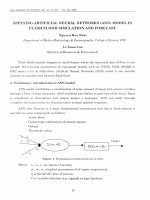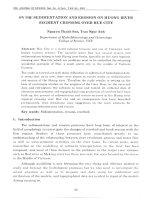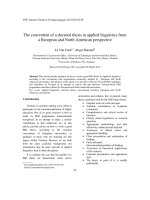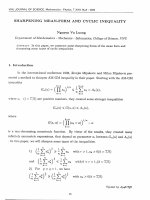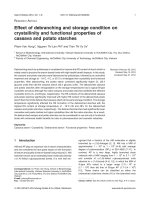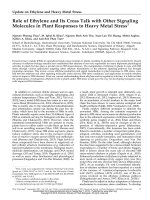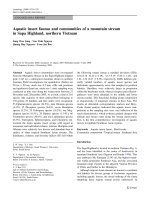DSpace at VNU: Out-of-plane exchange bias and magnetic anisotropy in MnPd Co multilayers
Bạn đang xem bản rút gọn của tài liệu. Xem và tải ngay bản đầy đủ của tài liệu tại đây (1.27 MB, 7 trang )
ARTICLE IN PRESS
Journal of Magnetism and Magnetic Materials 320 (2008) 3334–3340
Contents lists available at ScienceDirect
Journal of Magnetism and Magnetic Materials
journal homepage: www.elsevier.com/locate/jmmm
Out-of-plane exchange bias and magnetic anisotropy in MnPd/Co multilayers
N.H. Dung a,Ã, N.P. Thuy a,b, N.A. Tuan a, N.T. Long b, N.N. Phuoc c
a
b
c
International Training Institute for Materials Science (ITIMS), Hanoi University of Technology, 1 Dai Co Viet road, Hanoi, Vietnam
Faculty of Electronics and Telecommunications, College of Technology, Vietnam National University, Hanoi, Vietnam
Physics Department, National University of Singapore, Singapore
a r t i c l e in f o
a b s t r a c t
Article history:
Received 3 April 2008
Received in revised form
18 June 2008
Available online 15 July 2008
Magnetic and structural properties in [MnPd/Co]10 multilayers deposited onto Si(111) substrates have
been investigated. The dependences of anisotropy and exchange bias on the thicknesses of both MnPd
and Co layers have been studied. In most of the samples, the out-of-plane magnetic anisotropy and both
large out-of-plane and in-plane exchange biases have been observed at cryogenic temperature below
the blocking temperature TBE240 K. With appropriate MnPd and Co thicknesses, we have obtained
samples with a large out-of-plane exchange bias along with a large out-of-plane magnetic anisotropy.
The origin of the out-of-plane magnetic anisotropy in the samples has been suggested to be due to the
formation of CoPd interfacial alloys which have tensile in-plane strains, while the spin structure of
the antiferromagnetic layer at the interface which is believed to be responsible for exchange bias may be
the same as that of the bulk material. Also, the present study shows that the interplay between the outof-plane magnetic anisotropy and exchange bias is evident in our multilayers and plays an important
role in the out-of-plane exchange-bias mechanism.
& 2008 Elsevier B.V. All rights reserved.
PACS:
75.70.Cn
75.70.Ài
75.25.+z
75.30.Gw
Keywords:
Out-of-plane exchange bias
Out-of-plane magnetic anisotropy
Magnetic thin film
Multilayer
1. Introduction
The phenomenon of exchange bias between antiferromagnetic
(AF) and ferromagnetic (FM) materials has been studied extensively, since its discovery in 1956 by Meiklejohn and Bean [1].
However, most of the studies concentrate on the in-plane
configuration (the so-called in-plane exchange bias). The investigations on out-of-plane exchange bias have recently received
much attention because it is relevant in the quest for a better
understanding of the microscopic origin of the exchange bias
phenomenon and it might lead to wide applications in magnetic
sensors, perpendicular recording media, perpendicular magnetic
read heads and magnetic random access memories (MRAMs). So
far, several groups [2–13] have observed out-of-plane exchange
bias and magnetic anisotropy in multilayers but very few works
[8] have indicated the significant contribution for out-of-plane
magnetic anisotropy arising from the induced unidirectional
anisotropy. For the out-of-plane exchange bias mechanism, all
the studies concentrate on the explanation for the difference in
the exchange bias field (HE) in various directions based on the
orientation of the uncompensated AF spins at the interface. Some
à Corresponding author. Tel.: +84 4 8680787; fax: +84 4 8692963.
E-mail address: (N.H. Dung).
0304-8853/$ - see front matter & 2008 Elsevier B.V. All rights reserved.
doi:10.1016/j.jmmm.2008.07.007
authors [4,7] suggest that the spin structure at the interface is the
same as that of AF bulk, while others [5,13] believe in some
interfacial AF spin fluctuations.
Recently, our group has discovered a huge unidirectional
anisotropy in exchange-biased MnPd/Co bilayer systems in the
in-plane configuration [14]. From the fundamental viewpoint, it
will be interesting to extend our work from bilayers to multilayers
to investigate the role of out-of-plane exchange bias and magnetic
anisotropy for a better understanding of the physical origin of
exchange bias and related phenomena. In this paper, we therefore
focus our study on exchange bias in both the out-of-plane and inplane directions and out-of-plane magnetic anisotropy in [MnPd/Co]10
multilayers.
2. Experimental
Samples with the structure of Si(111)/[MnPd/Co]10 were
deposited at ambient temperature using the RF sputtering system.
The deposition was carried out in pure Ar gas with the pressure of
5 Â 10À3 mbar. No external field was applied during the deposition. The atomic composition analyses using both the energy
dispersive X-ray spectrometer (EDS) and the wavelength dispersive X-ray spectrometer (WDS) pointed out Mn:Pd ¼ 11:89.
Crystal structure was determined by X-ray diffraction (XRD) with
ARTICLE IN PRESS
N.H. Dung et al. / Journal of Magnetism and Magnetic Materials 320 (2008) 3334–3340
Cu Ka radiation (l ¼ 1.54056 A˚) and small incident angle (11). The
vibrating sample magnetometer (VSM) was used to characterize
the magnetic properties of the samples. For the exchange bias
study, all samples had to undergo the so-called field cooling (FC)
process. First, MnPd/Co multilayers deposited onto Si(111)
substrates were heated to 590 K and kept at that condition for
5 min, and then cooled down to room temperature in the presence
of a magnetic field of 5 kOe applied either in the film plane
(in-plane direction) or normal to the plane (out-of-plane direction). This process was realized in a vacuum chamber with the
pressure better than 10À5 mbar. The annealing at such high
temperature will stabilize the structure of the sample. The
samples were then cooled in a field of 5 kOe between the two
poles of the VSM system from room temperature down to
measurement temperature. In the present study, the hysteresis
loops were measured in a magnetic field up to 13.5 kOe at
cryogenic temperature in both the in-plane and out-of-plane
directions. It should be noted that the applied field direction in the
magnetization measurements is in the same direction as the
cooling field, except for some cases of additional experiments that
will be described in a later section.
3. Results
(220)
(200)
Intensity (a.u)
(111)
Fig. 1 shows XRD patterns for [MnPd/Co]10 multilayers. It is
observed that MnPd is polycrystalline with fcc phase. Meanwhile,
almost no peak for Co is found. It is likely caused by the less
crystallinity formation of Co layers. As a result, the average
saturation magnetization of these samples is only 320 emu/cm3,
much lower than that of Co bulk (about 1400 emu/cm3). Another
possibility is that the thickness of Co layer is not thick enough for
the detection of the diffraction peaks by XRD.
Hysteresis loops at 120 K for the sample series in which the Co
thickness (tCo) is varied from 2.5 to 10 nm while the MnPd
thickness (tMnPd) is fixed at 10 nm are shown in Fig. 2. The
negative shifts of the hysteresis loops show that exchange bias
effect exists in [MnPd/Co]10 multilayers in both the in-plane and
out-of-plane directions. Also, one can see the out-of-plane
orientation of the Co layer magnetization in the samples with
tCo o10 nm. However, the sample with tCo ¼ 10 nm exhibits an inplane magnetic anisotropy (the last graph in Fig. 2). This behavior
unambiguously demonstrates that the easy axis of Co layer
changes from the out-of-plane direction to the in-plane one with
increasing the Co thickness.
x = 4.5 nm
x = 3.5 nm
x = 2.5 nm
25
30
35
40
45
50
2θ
θ (deg.)
55
60
65
70
Fig. 1. X-ray diffraction patterns for [MnPd(10 nm)/Co(x nm)]10 (x ¼ 2.5, 3.5,
4.5 nm) multilayers with small incident angle (11).
3335
Shown in Fig. 3 are the hysteresis loops at 120 K for the sample
series in which tMnPd is varied from 3.5 to 30 nm while keeping tCo
at 3.5 nm. The negative shifts of the hysteresis loops in both the
in-plane and out-of-plane directions are also observable. Concerning the preferential orientation of the Co layer magnetization,
it is interesting to note that the easy axis of Co layer switches from
the in-plane direction (in the sample with the smallest tMnPd,
3.5 nm, as seen in the first graph in Fig. 3) to the out-of-plane one
as tMnPd increases.
In order to know better about the preferential orientation of
the Co layer magnetization at temperature higher than TB,
hysteresis loops were measured at room temperature for the
as-deposited samples. Besides, the samples annealed at 590 K for
5 min in vacuum were also used in these experiments. The results
indicated that the out-of-plane magnetic anisotropy is present in
most of the cases. Especially for the multilayer with tMnPd ¼ 10 nm
and tCo ¼ 7.5 nm, the in-plane anisotropy in the as-deposited
sample switched to the out-of-plane one after annealing (see
Fig. 4).
We have also carried out some additional hysteresis loop
measurements at cryogenic temperature in which the FC process
is similar to that described in a previous section but the
measurement field is applied both perpendicular and parallel to
the FC direction. A representative result depicted in Fig. 5 for the
sample with tMnPd ¼ 10 nm and tCo ¼ 5.5 nm shows a double shift
of the out-of-plane hysteresis loop after the in-plane FC. However,
no loop shift was observed in the case of the in-plane hysteresis
loop after the out-of-plane FC.
4. Discussion
It should be noted that the blocking temperature is quite
narrow for our multilayers and its value is around 240 K for all the
samples as can be seen in Fig. 6 for some representatives where
the temperature dependence of the HE is derived from the
hysteresis loops measured at various temperatures. Therefore,
the effect of variation of blocking temperature leading to variation
in the exchange bias properties which is usually observed in the
literature can be negligible in the present cases.
From the hysteresis loops in Fig. 2, the HE, the unidirectional
anisotropy energy or exchange bias coupling energy (JK), the
coercive field (HC) and the remanence-to-saturation magnetization ratio (MR/MS) for both the in-plane and out-of-plane cases at
120 K have been derived and are shown in Fig. 7 as a function of
the Co thickness. Here, JK was calculated by J K ¼ 12 Â HE Â MS Â t Co,
where HE is the exchange bias field, and tCo and MS are the
thickness and saturation magnetization of Co layer, respectively.
The factor of 12 in the above equation is because each Co layer has
two interfaces. It is worthwhile to note that from this figure the
maximum values of the HE are huge, up to 1650 and 950 Oe for
the out-of-plane and in-plane cases, respectively, and much
higher than those reported in the previous studies for FePt/FeMn
multilayers [10,11]. Another behavior of this sample series is that
the out-of-plane JK is larger than the in-plane one and JK reaches
the maximum values of 0.17 and 0.15 erg/cm2 for the out-of-plane
and in-plane cases, respectively, at the largest tCo.
Shown in Fig. 8 is the variation of the HE, the JK, the HC and
MR/MS with the tMnPd for both the in-plane and out-of-plane
cases at 120 K derived from the experimental curves in Fig. 3.
Of interest are the opposite trends of HE in these two configurations. Specifically, the out-of-plane HE increases with tMnPd from
3.5 to 7.5 nm, approaching a maximum value of 1650 Oe, and
decreases gradually with increasing tMnPd larger than 7.5 nm. On
the contrary, a decrease in HE for the in-plane case can be seen
clearly with increasing tMnPd from 3.5 to 7.5 nm down to
ARTICLE IN PRESS
3336
N.H. Dung et al. / Journal of Magnetism and Magnetic Materials 320 (2008) 3334–3340
1.0
Out-of-plane
In-plane
Out-of-plane
In-plane
M/MS
0.5
0.0
-0.5
-1.0
1.0
tCo = 5.5 nm
tCo = 2.5 nm
Out-of-plane
In-plane
Out-of-plane
In-plane
M/MS
0.5
0.0
-0.5
-1.0
tCo = 7.5 nm
tCo = 3.5 nm
Out-of-plane
In-plane
1.0
Out-of-plane
In-plane
M/MS
0.5
0.0
-0.5
-1.0
tCo = 4.5 nm
-10
-5
0
H (kOe)
5
10
tCo = 10 nm
-10
-5
0
H (kOe)
5
10
Fig. 2. Out-of-plane and in-plane hysteresis loops at 120 K for [MnPd(10 nm)/Co(x nm)]10 (x ¼ 2.5, 3.5, 4.5, 5.5, 7.5, 10 nm) multilayers. The out-of-plane loops were
measured with the field applied along the film normal, while the in-plane loops were measured with the field applied in the film plane. The applied field direction is in the
same direction as the cooling field.
a minimum value of 250 Oe, followed by an increase with tMnPd
over 7.5 nm. These are very different from the results reported by
Phuoc and Suzuki for FePt/FeMn multilayer system [10,11].
We note here that by choosing appropriate tCo and tMnPd
we can obtain samples with the out-of-plane anisotropy
which have a nearly ‘‘pure’’ out-of-plane exchange bias, i.e. the
in-plane exchange bias is almost suppressed in the sample with
the strong out-of-plane anisotropy. The sample with tCo ¼ 3.5 nm
and tMnPd ¼ 7.5 nm as mentioned above is a good example (see
Figs. 3 and 8). This behavior is again rather unusual comparing with
other works, e.g. in [FeMn/FePt]10 multilayers [10] where both outof-plane and in-plane exchange biases are always coexistent.
As can be seen in Figs. 7 and 8, HC for the samples depends on
both tCo and tMnPd. Especially for the multilayers with large tCo and
also small tMnPd, the opposite behavior of out-of-plane and inplane HC with tCo and also tMnPd reflects the modification of the
anisotropy property in these samples. Meanwhile, the values of
the MR/MS which are obtained after recentering the loops for the
HE also vary with tCo and tMnPd in response to the change of the
anisotropy property. The ratio of MR/MS obtained from the out-ofplane hysteresis loops for the samples with the out-of-plane
anisotropy is rather high, up to 0.9 when the tMnPd is over 15 nm as
shown in Fig. 8.
Regarding the origin of the out-of-plane magnetic anisotropy,
based on the fact that the out-of-plane magnetic anisotropy is
already existent at room temperature and can be obtained in the
case of the multilayer with tMnPd ¼ 10 nm and tCo ¼ 7.5 nm after
annealing as mentioned above (Fig. 4), we suggest that the out-ofplane magnetic anisotropy observed in most of our samples most
likely comes from the formation of CoPd alloys at the interface
between Co and MnPd layers. This assumption is consistent with
the previous studies on out-of-plane magnetic anisotropy in Co/Pd
multilayers [15,16]. These alloys are known to have extremely
large negative magnetostriction constants and can experience
significant tensile in-plane strains due to the lattice mismatch
with MnPd layers in the multilayers leading to the out-of-plane
orientation of the FM magnetization. The existence of the in-plane
anisotropy in the multilayer with the smallest tMnPd in the sample
series with varying tMnPd (see Fig. 3) may originate from
the reduction of the tensile in-plane strains of CoPd alloys.
In other words, the spin switching between the in-plane and outof-plane directions in this sample series can be reversibly
controlled by strain modulation through the inverse magnetostrictive effect [17].
From the area enclosed between the in-plane and out-of-plane
magnetization curves, the effective magnetic anisotropy (Keff)
can be readily obtained. A positive (or negative) Keff describes
the case of a preferential direction of the FM magnetization
along the out-of-plane (or in-plane) direction. It is well established that the Keff could be phenomenologically separated
into a volume contribution (KV) and a contribution from the
interfaces (KS), and approximately described by Keff ¼ KV+2KS/tCo
ARTICLE IN PRESS
N.H. Dung et al. / Journal of Magnetism and Magnetic Materials 320 (2008) 3334–3340
1.0
3337
Out-of-plane
In-plane
Out-of-plane
In-plane
M/MS
0.5
0.0
-0.5
-1.0
1.0
tMnPd = 10 nm
tMnPd = 3.5 nm
Out-of-plane
In-plane
Out-of-plane
In-plane
M/MS
0.5
0.0
-0.5
-1.0
1.0
tMnPd = 5.5 nm
tMnPd = 15.5 nm
Out-of-plane
In-plane
Out-of-plane
In-plane
M/MS
0.5
0.0
-0.5
-1.0
tMnPd = 7.5 nm
-10
-5
0
H (kOe)
5
10
tMnPd = 30 nm
-10
-5
0
H (kOe)
5
10
Fig. 3. Out-of-plane and in-plane hysteresis loops at 120 K for [MnPd(y nm)/Co(3.5 nm)]10 (y ¼ 3.5, 5.5, 7.5, 10, 15.5, 30 nm) multilayers. The applied field direction is in the
same direction as the cooling field.
or KefftCo ¼ KVtCo+2KS [18]. By combining this equation with the
linear fit of the plot of the product Keff tCo versus tCo, one can
readily deduce KV from the slope of the fit line and 2KS from the
vertical axis intercept (see Fig. 9). The value of KS obtained by this
way for the sample series with varying tCo is about 0.6 erg/cm2,
which is close to that reported by Engel et al. [19] for
Co/Pd multilayers (0.63 erg/cm3), while |KV| is in the order of
106 erg/cm3, which is much lower than that found in the literature
[18]. It should be noted that in the above calculations we have
ignored the influence of the induced unidirectional anisotropy on
the FM anisotropy, which is not simply the loop shifts.
The plot in Fig. 9 also indicates that the easy axis of Co layer
transforms from the out-of-plane direction into the in-plane one
as tCo passes a critical value of about 9 nm. Of interest is that this
value is much larger than that in previous studies [18] as a result
of the reduction of the Co layer magnetization which leads to a
decrease in demagnetizing field, an opponent of the out-of-plane
anisotropy. Since MS is slightly different over the tCo range from
2.5 to 10 nm, the low saturation magnetization is not directly
related to the low magnetization of CoPd interfacial alloys. It is
likely because the large entropy for these interfacial layers would
disorder the Co layers, thus lowering its magnetization. This
magnetization disordering mechanism is similar to that observed
in Co/Re multilayers [20]. Another possibility is that the strains
may give rise to the less crystallinity for Co layers.
Since MnPd layers are polycrystalline and not textured as
determined from XRD, we assume that isotropic crystallographic
orientation is present for these AF layers. Upon the FC process, the
interfacial AF spins are presumed to be frozen into the preferential
bulk spin anisotropy axes which are closest to the orientation of
the interfacial FM spins due to the bilinear exchange interaction
between the FM spins and AF spins at the interface. The
reorientation of the interfacial AF spins or repopulation of the
AF domains with the magnetic easy axes leading to uncompensated spins or net moments at the interface and forming AF
regions locally oriented in various directions can induce a
unidirectional anisotropy at the interface and give rise to
exchange bias. These AF regions are not necessarily AF domains
in the strict thermodynamic sense, but rather are areas where the
properties of the AF, most likely the orientation of the uncompensated AF spins at the interface, are modified due to the
presence of the FM [21]. Here, the FM domains are expected to be
much larger than the AF regions so that each FM domain will feel
the average effect of several of these AF regions and can be
essentially treated as a separate sample [22]. Then the uncompensated spins of various AF regions are distributed in a cone with
a limited half-apex angle and the averaged direction of the
uncompensated AF spins is along the direction of the FM spins.
Naturally, one may expect that the FM spins at the interface
favor to align in the FC direction. However in some cases, they are
canted with the FC direction because our cooling field is not
enough to entirely saturate the magnetization along the hard axis
of the FM layer, especially for the samples with the strong out-ofplane magnetic anisotropy field cooled in the in-plane direction
ARTICLE IN PRESS
3338
N.H. Dung et al. / Journal of Magnetism and Magnetic Materials 320 (2008) 3334–3340
Out-of-plane
1.0
1.2
In-plane
0.9
HE (kOe)
M/MS
0.5
0.0
Out-of-plane
0.6
0.3
In-plane
-0.5
0.0
-1.0
As-deposited
1.2
Out-of-plane
0.9
In-plane
HE (kOe)
1.0
M/MS
0.5
Out-of-plane
0.6
In-plane
0.3
0.0
0.0
-0.5
120
-1.0
After annealing
-10
-5
0
H (kOe)
5
10
Fig. 4. Out-of-plane and in-plane hysteresis loops at room temperature for
[MnPd(10 nm)/Co(7.5 nm)]10 as-deposited and after-annealing multilayers.
1.0
Out-of-plane
M/MS
0.5
0.0
-0.5
HFC ⊥ Plane
HFC // Plane
-1.0
-10
-5
0
H (kOe)
5
10
Fig. 5. Out-of-plane hysteresis loops at 120 K for [MnPd(10 nm)/Co(5.5 nm)]10
multilayers field cooled in the out-of-plane and in-plane directions.
(see Fig. 10). In these cases, with the out-of-plane FM easy axis,
larger net moment components can be induced along the out-ofplane cooling field than those along the in-plane cooling field,
leading to the higher out-of-plane HE than the in-plane one, and
vice versa. These arguments explain why the in-plane HE seems to
140
160
180
200
T (K)
220
240
260
Fig. 6. Temperature dependence of in-plane and out-of-plane exchange bias fields
(HE) for (a) [MnPd(10 nm)/Co(4.5 nm)]10 and (b) [MnPd(10 nm)/Co(10 nm)]10
multilayers.
be suppressed in the sample with the strong out-of-plane
magnetic anisotropy as mentioned above. They are also in good
agreement with the experimental results in most of the present
cases, except for the case of [MnPd(30 nm)/Co(3.5 nm)]10 multilayer. In this exception, the sample with the out-of-plane
magnetic anisotropy, however, exhibits the smaller out-of-plane
HE than the in-plane one (see Figs. 3 and 8). The orientation of the
interfacial AF spins may not be strongly influenced by the
orientation of the FM anisotropy as a result of the strong
anisotropy of the thick AF layer [7]. Moreover, some demagnetizing effects will tend to keep them in the film plane giving rise to
smaller net moment components induced along the out-of-plane
FC direction than those along the in-plane FC direction. Based on
the above reasons, the opposite trends of HE in the in-plane and
out-of-plane configurations in the sample series with changing
tMnPd as shown in Fig. 8 can be clarified.
As for [MnPd(10 nm)/Co(10 nm)]10 multilayer, since the FM
anisotropy is expected to be very small, the cooling field is
sufficient to completely saturate the FM magnetization in both the
in-plane and out-of-plane directions leading to that the interfacial
FM spins is along the FC direction. Therefore, the fact that the inplane HE is nearly equal to the out-of-plane one as seen in Figs. 2
and 6b again confirms the bulk spin structure of the AF layers.
In order to explain the behavior of exchange bias in the sample
series with varying tCo (see Fig. 7), it should be noticed that the
interfacial FM spins align in the FC direction when the cooling
field is applied along the film normal. The HE is usually expected
to be inversely proportional to tCo above a certain Co thickness.
Thus, with tCo larger than 5.5 nm the out-of-plane HE decreases,
indicating that this is an interfacial effect. This is confirmed by the
fact that JK for the out-of-plane case is only slightly different over
ARTICLE IN PRESS
N.H. Dung et al. / Journal of Magnetism and Magnetic Materials 320 (2008) 3334–3340
2.0
2.0
1.5
Out-of-plane
HE (kOe)
HE (kOe)
1.5
1.0
In-plane
Out-of-plane
1.0
0.5
In-plane
0.5
0.0
0.12
0.0
Out-of-plane
JK (erg/cm2)
0.15
JK (kOe)
3339
0.10
0.09
Out-of-plane
0.06
0.03
In-plane
In-plane
0.05
0.00
5
4
4
Out-of-plane
3
HC (kOe)
HC (kOe)
0.00
Out-of-plane
3
2
2
1
1
In-plane
0
1.0
In-plane
Out-of-plane
0
0.8
MR/MS
1.0
Out-of-plane
0.8
0.6
MR/MS
0.4
0.6
0.2
In-plane
0.4
0.0
0
0.2
In-plane
0.0
2
4
6
8
10
5
10
15
20
tMnPd (nm)
25
30
Fig. 8. MnPd thickness dependence of exchange bias field (HE), exchange bias
coupling energy (JK), coercive field (HC) and remanence-to-saturation magnetization ratio (MR/MS) at 120 K for [MnPd/Co]10 multilayers.
tCo (nm)
Fig. 7. Co thickness dependence of exchange bias field (HE), exchange bias
coupling energy (JK), coercive field (HC) and remanence-to-saturation magnetization ratio (MR/MS) at 120 K for [MnPd/Co]10 multilayers.
this tCo range. An increase in the out-of-plane HE with tCo below
5.5 nm may be related to the formation of CoPd interfacial alloys
depending on the FM thickness in this range. Meanwhile, an
increase in the in-plane JK with tCo is obviously affected by the
strong out-of-plane FM anisotropy and a tendency toward the inplane FM anisotropy with increasing tCo.
The discrepant behavior of the hysteresis loops as shown in
Fig. 5 affirms that the FM anisotropy is clearly affected by the
induced unidirectional anisotropy, i.e. the competition between
the FM and unidirectional anisotropies in the case of the in-plane
FC and/or the enhanced out-of-plane magnetic anisotropy in the
case of the out-of-plane FC. These features may originate from the
strong JK in our samples and they are rather unique compared
ARTICLE IN PRESS
3340
N.H. Dung et al. / Journal of Magnetism and Magnetic Materials 320 (2008) 3334–3340
Keff (106 erg/cm3)
1.5
2KS
KefftCo (erg/cm2)
1.0
sample and the sign for the net exchange bias for each of these
domains is set by the direction of the magnetization of the FM
domain, the FM spin canting results in both the negative and
positive HE forming the double-shifted loop. In a similar way, this
argument also indicates why no shifted loop could be seen in the
in-plane measurements after the out-of-plane FC.
3
2
1
0
2
0.5
4
6
8
tCo (nm)
10
5. Conclusions
KV
0.0
T = 120 K
-0.5
0
2
4
6
tCo (nm)
8
10
Fig. 9. The plot of the product KefftCo versus tCo at 120 K for [MnPd(10 nm)/
Co(x nm)]10 (x ¼ 2.5, 3.5, 4.5, 5.5, 7.5, 10 nm) multilayers. The sketches are taken
from Johnson et al. [18]. The inset indicates the dependence of Keff on the Co
thickness.
In summary, we have systematically examined both in-plane and
out-of-plane exchange biases of the multilayers of [MnPd/Co]10 as a
function of the thicknesses of MnPd and Co layers. The results show
a strong out-of-plane magnetic anisotropy originating from the
interface anisotropy of MnPd/Co multilayers and also from the
induced unidirectional anisotropy, and exchange bias coming from
the spin structure at the interface which may be similar to that of
the AF bulk. In return, this strong out-of-plane anisotropy plays a
vital role in the behavior of in-plane and out-of-plane exchange
biases, and vice versa, suggesting that one must take into account
the interplay between out-of-plane magnetic anisotropy and
exchange bias when studying out-of-plane exchange biased systems.
FM domain
Acknowledgement
This work was supported by the State Program on Fundamental Research of Vietnam in the periods 2006–2007 (Grants
4.049.06 and 4.105.06) and 2008–2009.
FM
AF
HFC
References
AF region
HFC
Direction of
uncompensatedAF spins
Averaged direction of
uncompensated AF spins
FM
AF
Fig. 10. Sketch of the magnetic configurations at the interface in the multilayers
with the out-of-plane anisotropy field cooled along the out-of-plane (a) and inplane (b) directions, and the corresponding configurations (c) and (d) simplified
for explanation of exchange bias.
with previously published studies on out-of-plane anisotropy and
exchange bias. The existence of the double-shifted loop as seen in
Fig. 5, which rather looks like a symmetric double-shifted loop
reported by Bru¨ck et al. [21], is a further proof of the FM spin
canting. After the out-of-plane FC, the projection of the uncompensated AF spins to the out-of-plane direction is along the ‘up’
direction, leading to a single-shifted loop (see Fig. 10a,c), while the
small projection of the uncompensated AF spins to the out-ofplane direction is equally spread along the ‘up’ and ‘down’
directions due to the FM spin canting after the in-plane FC, giving
rise to both the negative and positive HE (see Fig. 10b,d). In other
words, since each FM domain can be regarded as a separate
[1] W.H. Meiklejohn, C.P. Bean, Phys. Rev. 102 (1956) 1413.
[2] B. Kagerer, Ch. Binek, W. Kleemann, J. Magn. Magn. Mater. 217 (2000) 139.
[3] Ch. Binek, B. Kagerer, S. Kainz, W. Kleemann, J. Magn. Magn. Mater. 226–230
(2001) 1814.
[4] S. Matt, K. Takano, S.S.P. Parkin, E.E. Fullerton, Phys. Rev. Lett. 87 (2001)
087202.
[5] C.H. Marrows, Phys. Rev. B 68 (2003) 012405.
[6] F. Garcia, J. Sort, B. Rodmacq, S. Auffret, B. Dieny, Appl. Phys. Lett. 83 (2003)
3537.
[7] Z.Y. Liu, J. Magn. Magn. Mater. 281 (2004) 247.
˜ ach,
[8] J. Sort, F. Garcia, S. Auffret, B. Rodmacq, B. Dieny, V. Langlais, S. Surin
˜ oz, M.D. Baro´, J. Nogue´s, Appl. Phys. Lett. 87 (2005) 242504.
J.S. Mun
[9] L. Sun, P.C. Searson, C.L. Chien, Phys. Rev. B 71 (2005) 012417.
[10] N.N. Phuoc, T. Suzuki, J. Appl. Phys. 99 (2006) 08C107.
[11] N.N. Phuoc, T. Suzuki, IEEE Trans. Magn. 42 (2006) 2996.
[12] S.S. Kim, J.Y. Hwang, J.R. Rhee, J. Magn. Magn. Mater. 310 (2007) 2310.
[13] N.N. Phuoc, T. Suzuki, J. Appl. Phys. 103 (2008) 07C113.
[14] N.P. Thuy, N.A. Tuan, N.N. Phuoc, N.T. Nam, T.D. Hien, N.H. Hai, J. Magn. Magn.
Mater. 304 (2006) 41.
[15] S.K. Kim, V.A. Chernov, Y.M. Koo, J. Magn. Magn. Mater. 170 (1997) L7.
[16] J.I. Hong, S. Sankar, A.E. Berkowitz, W.F. Egelhoff Jr, J. Magn. Magn. Mater. 285
(2005) 359.
[17] S.K. Kim, J.W. Lee, J.R. Jeong, S.C. Shin, J. Magn. Magn. Mater. 240 (2002) 543.
[18] M.T. Johnson, P.J.H. Bloemen, F.J.A. den Broeder, J.J. de Vries, Rep. Prog. Phys.
59 (1996) 1409.
[19] B.N. Engel, C.D. England, R.A. van Leeuwen, M.H. Wiedmann, C.M. Falco, Phys.
Rev. Lett. 67 (1991) 1910.
[20] T. Charlton, J. McChesney, D. Lederman, F. Zhang, J. Zachary Hilt, A. Michael,
J. Pechan, Phys. Rev. B 59 (1999) 11897.
˜ ach, J.S. Mun
˜ oz, B. Dieny, M.D. Baro´, J. Nogue´s,
[21] S. Bru¨ck, J. Sort, V. Baltz, S. Surin
Adv. Mater. 17 (2005) 2978.
[22] I.V. Roshchin, O. Petracic, R. Morales, Z.-P. Li, X. Batlle, I.K. Schuller, Europhys.
Lett. 71 (2005) 297.

